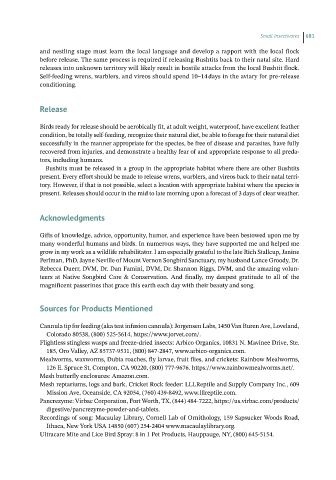Page 680 - Hand rearing birds second
P. 680
Small Insectivores 681
and nestling stage must learn the local language and develop a rapport with the local flock
before release. The same process is required if releasing Bushtits back to their natal site. Hard
releases into unknown territory will likely result in hostile attacks from the local Bushtit flock.
Self‐feeding wrens, warblers, and vireos should spend 10–14 days in the aviary for pre‐release
conditioning.
Release
Birds ready for release should be aerobically fit, at adult weight, waterproof, have excellent feather
condition, be totally self‐feeding, recognize their natural diet, be able to forage for their natural diet
successfully in the manner appropriate for the species, be free of disease and parasites, have fully
recovered from injuries, and demonstrate a healthy fear of and appropriate response to all preda-
tors, including humans.
Bushtits must be released in a group in the appropriate habitat where there are other Bushtits
present. Every effort should be made to release wrens, warblers, and vireos back to their natal terri-
tory. However, if that is not possible, select a location with appropriate habitat where the species is
present. Releases should occur in the mid to late morning upon a forecast of 3 days of clear weather.
Acknowledgments
Gifts of knowledge, advice, opportunity, humor, and experience have been bestowed upon me by
many wonderful humans and birds. In numerous ways, they have supported me and helped me
grow in my work as a wildlife rehabilitator. I am especially grateful to the late Rich Stallcup, Janine
Perlman, PhD, Jayne Neville of Mount Vernon Songbird Sanctuary, my husband Lance Groody, Dr.
Rebecca Duerr, DVM, Dr. Dan Famini, DVM, Dr. Shannon Riggs, DVM, and the amazing volun-
teers at Native Songbird Care & Conservation. And finally, my deepest gratitude to all of the
magnificent passerines that grace this earth each day with their beauty and song.
Sourcesfor ProductsMentioned
Cannula tip for feeding (aka teat infusion cannula): Jorgensen Labs, 1450 Van Buren Ave, Loveland,
Colorado 80538, (800) 525‐5614, https://www.jorvet.com/.
Flightless stingless wasps and freeze‐dried insects: Arbico Organics, 10831 N. Mavinee Drive, Ste.
185, Oro Valley, AZ 85737‐9531, (800) 847‐2847, www.arbico‐organics.com.
Mealworms, waxworms, Dubia roaches, fly larvae, fruit flies, and crickets: Rainbow Mealworms,
126 E. Spruce St, Compton, CA 90220, (800) 777‐9676. https://www.rainbowmealworms.net/.
Mesh butterfly enclosures: Amazon.com.
Mesh reptariums, logs and bark, Cricket Rock feeder: LLLReptile and Supply Company Inc., 609
Mission Ave, Oceanside, CA 92054, (760) 439‐8492, www.lllreptile.com.
Pancrezyme: Virbac Corporation, Fort Worth, TX, (844) 484‐7222, https://us.virbac.com/products/
digestive/pancrezyme‐powder‐and‐tablets.
Recordings of song: Macaulay Library, Cornell Lab of Ornithology, 159 Sapsucker Woods Road,
Ithaca, New York USA 14850 (607) 254‐2404 www.macaulaylibrary.org.
Ultracare Mite and Lice Bird Spray: 8 in 1 Pet Products, Hauppauge, NY, (800) 645‐5154.

